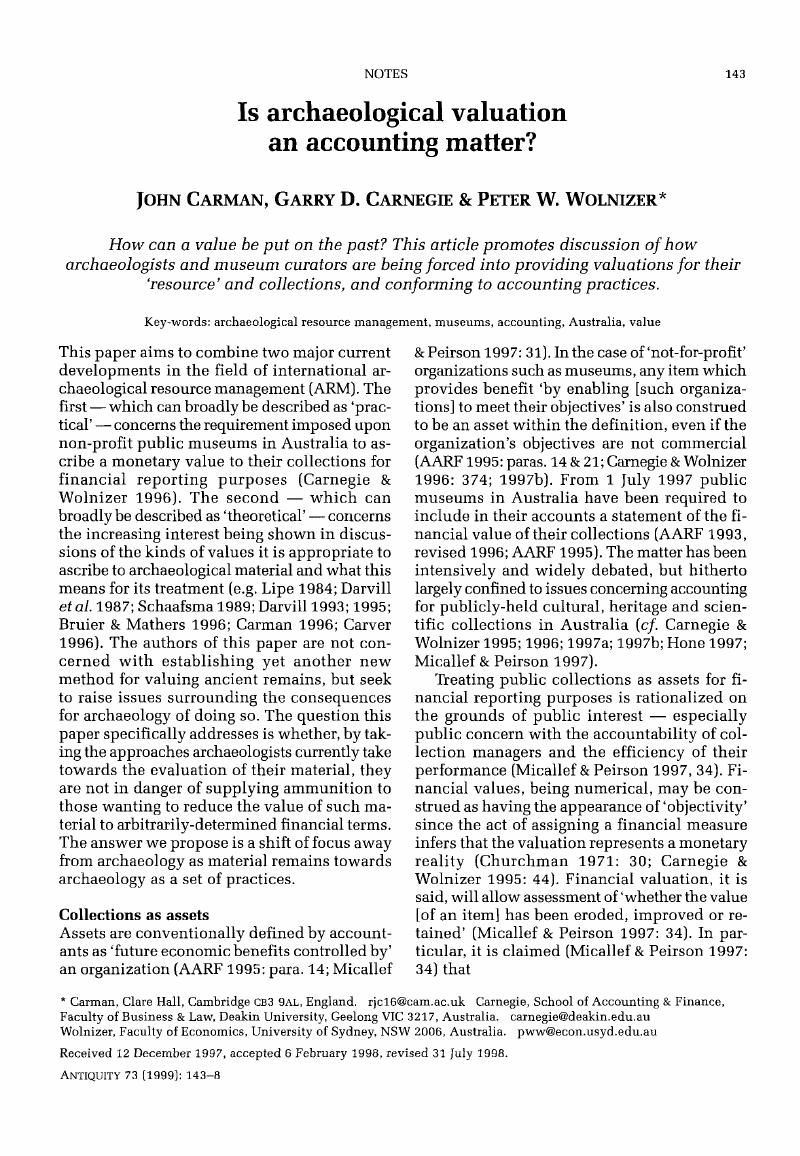Crossref Citations
This article has been cited by the following publications. This list is generated based on data provided by Crossref.
Ucko, Peter J.
1998.
The Biography of a Collection: The Sir Flinders Petrie Palestinian Collection and the Role of University Museums.
Museum Management and Curatorship,
Vol. 17,
Issue. 4,
p.
351.
Walderhaug Saetersdal, Eva M.
2000.
Ethics, politics and practices in rock art conservation.
Public Archaeology,
Vol. 1,
Issue. 3,
p.
163.
Carnegie, Garry D.
and
Napier, Christopher J.
2002.
Exploring comparative international accounting history.
Accounting, Auditing & Accountability Journal,
Vol. 15,
Issue. 5,
p.
689.
Barton, Allan D.
2002.
Public‐Sector Accounting:A Common Reporting Framework? A Rejoinder.
Australian Accounting Review,
Vol. 12,
Issue. 28,
p.
41.
Potter, Brad
2002.
Financial accounting reforms in the Australian public sector.
Accounting, Auditing & Accountability Journal,
Vol. 15,
Issue. 1,
p.
69.
Hope, Christopher
and
Morimoto, Risako
2003.
An Empirical Application of Probabilistic CBA: 3 Case Studies of Dams in Malaysia, Nepal and Turkey.
SSRN Electronic Journal ,
Susie Chung, Yun Shun
2003.
Object as Exhibit: legitimising the building of the National Museum of Korea.
International Journal of Heritage Studies,
Vol. 9,
Issue. 3,
p.
229.
Morimoto, Risako
and
Hope, Chris
2004.
Applying a cost-benefit analysis model to the Three Gorges project in China.
Impact Assessment and Project Appraisal,
Vol. 22,
Issue. 3,
p.
205.
Carnegie, Garry D.
and
West, Brian P.
2005.
Making accounting accountable in the public sector.
Critical Perspectives on Accounting,
Vol. 16,
Issue. 7,
p.
905.
Darvill, Timothy
2007.
Research frameworks for World Heritage Sites and the conceptualization of archaeological knowledge.
World Archaeology,
Vol. 39,
Issue. 3,
p.
436.
West, Brian
and
Carnegie, Garry D.
2010.
Accounting's chaotic margins.
Accounting, Auditing & Accountability Journal,
Vol. 23,
Issue. 2,
p.
201.
Carnegie, Garry D.
Sidaway, Shannon
and
West, Brian
2013.
A Chaotic Field of Practice: Financial Reporting of the Library Collections of Australia's Public Universities, 2007–2011.
Australian Academic & Research Libraries,
Vol. 44,
Issue. 4,
p.
195.
Sánchez, Jaime Almansa
2015.
Ethics and Archaeological Praxis.
p.
141.
Carman, John
2018.
Links: Going Beyond Cultural Property.
Archaeologies,
Vol. 14,
Issue. 1,
p.
164.
Dupeyron, Agathe
2020.
Archaeological Heritage as a Resource for Development: Definitions, Issues, and Opportunities for Evaluation.
Public Archaeology,
Vol. 19,
Issue. 1-4,
p.
3.
Ferri, Paolo
Sidaway, Shannon I.L.
and
Carnegie, Garry D.
2021.
The paradox of accounting for cultural heritage: a longitudinal study on the financial reporting of heritage assets of major Australian public cultural institutions (1992–2019).
Accounting, Auditing & Accountability Journal,
Vol. 34,
Issue. 4,
p.
983.
Aitchison, Kenneth
2021.
No More Polluter Pays Principle: opportunities and challenges of public benefit provision in UK development-led archaeology.
Internet Archaeology,
Carnegie, Garry D.
Ferri, Paolo
Parker, Lee D.
Sidaway, Shannon I. L.
and
Tsahuridu, Eva E.
2022.
Accounting as Technical, Social and Moral Practice: The Monetary Valuation of Public Cultural, Heritage and Scientific Collections in Financial Reports.
Australian Accounting Review,
Vol. 32,
Issue. 4,
p.
460.





